Exploring Cardoon: The Versatile Vegetable Uncovered


Intro
Cardoon, often flying under the culinary radar, is a vegetable that's not just a pretty face—its resemblance to an artichoke is striking, yet it's usually overlooked. Known scientifically as Cynara cardunculus, this formidable vegetable can add both flavor and flair to your meals. As we navigate through this guide, we'll untangle its tangled stems and fleshy leaves, exploring how to incorporate such an interesting ingredient into your cooking practices.
The deep culinary roots of cardoon run through Mediterranean cuisines, where it's celebrated for its unique taste profile. It has a mild, slightly nutty flavor that can shine when properly prepared. Through this article, we're not just going to know about cardoon but also learn to embrace it, giving you fresh perspectives in the kitchen. Each section will provide invaluable insight, from its basic characteristics to sophisticated cooking techniques.
Whether you're a curious cooking novice or a seasoned chef looking for ways to break out of the monotony, understanding cardoon will open doors to creativity that you may not have considered before. Let's dig in!
Recipe Highlight
Cardoon Gratin
Imagine a dish that showcases cardoon's textures and flavors in a cozy setting— Cardoon Gratin is just that. Comfort food often revolves around creamy layers and baked goodness, and this recipe is the epitome of that.
Essential Ingredients:
- Fresh cardoon stalks
- Heavy cream
- Grated Parmesan cheese
- Breadcrumbs
- Garlic, minced
- Olive oil
- Salt and pepper to taste
Preparation Time:
Approximately 45 minutes
Servings:
Serves 4-6 people
Step-by-Step Instructions
- Preparation of Cardoon: Begin by trimming the cardoon stalks and removing any tough fibers. Cut them into manageable pieces about 3 inches long.
- Cooking Cardoon: In a pot, bring salted water to a boil. Add the cardoon pieces and blanch for about 5 to 7 minutes. They should begin to soften but not fully cook. Drain and set aside.
- Building the Gratin: In a mixing bowl, combine the heavy cream with minced garlic, salt, and pepper. Now, in a greased baking dish, layer the blanched cardoon pieces, pour over the cream mixture, and sprinkle grated Parmesan cheese on top.
- Final Touches: Finish by layering breadcrumbs over the cheese. Drizzle olive oil on the top for some extra richness.
- Baking: Preheat the oven to 375°F (190°C) and bake for about 25-30 minutes or until the top is golden and bubbling.
"In the art of cooking, simplicity often holds the key to greatness."
Cooking Techniques and Insider Advice
- Blanching: This technique helps to ease the bitterness of the cardoon while retaining its natural color. This step cannot be skipped!
- Gratin Texture: For a crispier topping, broil for the last few minutes of cooking.
- Avoiding Common Mistakes: Don’t skip seasoning the cream— it’s crucial to bring out all the flavors.
Variations and Substitutions
If you're looking to tailor this dish, here are some alternatives:
- Non-Dairy Option: Swap heavy cream with coconut cream for a vegan-friendly alternative.
- Adding Flavors: Throw in some sautéed onions or mushrooms for an earthy touch.
- Pairing: Serve it alongside a fresh green salad or grilled chicken for a balanced meal.
Time-Saving Cooking Tips
- Prep Ahead: Pre-chop your cardoon and store it in water with a splash of lemon juice to prevent browning.
- Tools to Use: A mandoline slicer will help in dealing with the cardoon in a jiffy.
- Make More: Prepare a double batch and freeze half of it, so you'll have an easy meal ready for a busy night.
Nutritional Information
- Calories: Roughly 250 calories per serving.
- Key Nutrients: Rich in fiber, vitamins C and K, and antioxidants. It’s a fantastic addition to a healthy diet.
- Diet Suitability: This dish can be adapted for vegetarian or gluten-free diets by using gluten-free breadcrumbs.
As we conclude this section, it's clear that cardoon can be a star in the culinary world when embraced properly. Take these tips and recipes to explore the array of flavors this vegetable has to offer.
Preamble to Cardoon
Cardoon, often over looked in the vast world of vegetables, merits attention for its unique characteristics and culinary potential. As an artichoke's lesser-known cousin, this thistle-like plant may strike a curious note among food enthusiasts. Understanding cardoon's nuances isn’t just about the taste; it’s about appreciating a historical backdrop rich with flavors and traditions. This section delves deeply into cardoon, its role, and the treasures it holds for both novices and expert chefs alike.
Defining Cardoon
Cardoon, scientifically known as Cynara cardunculus, is an edible plant that few might encounter, yet its profile is fascinating. The large, leafy shoots, striking in their green and purple hues, resemble the globe artichoke but deliver a distinct flavor. Imagine biting into a tender stem with a slightly nutty and earthy taste, reminiscent of celery or artichoke hearts. This hearty vegetable is more than just a curiosity; it’s a canvas for creativity in the kitchen.
It thrives in various climates, though it loves the Mediterranean warmth. As culinary aficionados seek out new flavors and textures, cardoon stands out as a gem worthy of exploration. Its fibrous texture makes it suitable for various cooking methods, from boiling to grilling, allowing it to shine in countless dishes.
Historical Background
The journey of cardoon stretches back to ancient times, tracing roots to the Mediterranean region. Historically, Mediterranean cultures revered this plant, evident from its inclusion in Roman recipes. Documented well before the fall of the Roman Empire, it found its way into the hearts (and stomachs) of food lovers.
The Renaissance brought renewed interest in cardoon, leading to its integration into various European cuisines. Italians, for instance, cultivated it extensively, celebrating it during festivals to honor their agricultural heritage. From the towns along the Italian coast to markets in Spain, cardoon became a staple, often served alongside meats or in rich stews.
However, the industrial age saw its decline, overshadowed by more commercially popular vegetables. Today, cardoon is witnessing a renaissance as chefs and home cooks rediscover this storied vegetable. Reviving its culinary status not only honors tradition but also highlights its adaptability in modern kitchens. The resurgence of interest emphasizes the importance of cardoon in both historical and contemporary culinary arts.
Botanical Characteristics

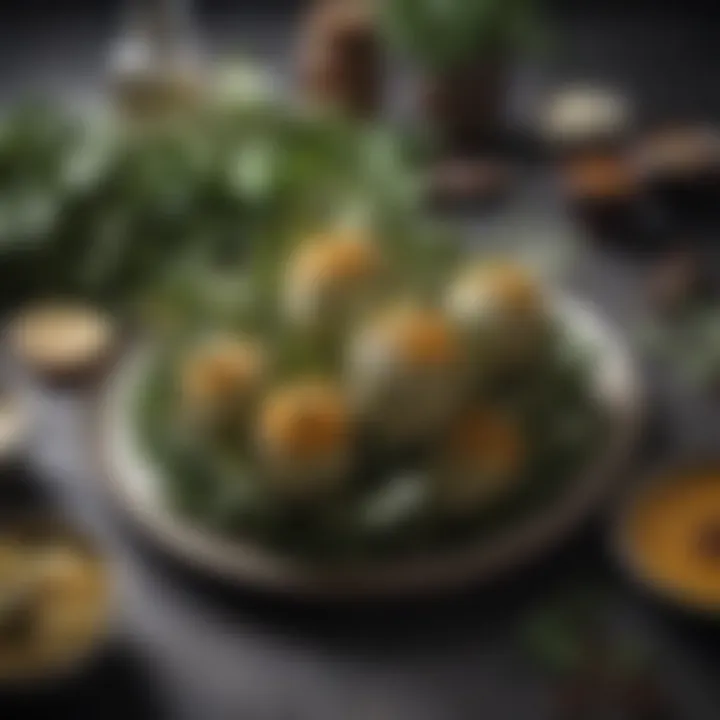
Understanding the botanical characteristics of cardoon is essential for appreciating its unique attributes and potential uses in culinary settings. Knowledge of its classification and growth conditions allows both amateur and experienced cooks to make informed decisions, whether that be in the garden or the kitchen. The way cardoon is cultivated has a direct impact on its flavor, texture, and overall quality of the vegetable, which makes this a foundational topic for anyone aiming to use it effectively in their meals.
Classification and Varieties
Cardoon, scientifically known as Cynara cardunculus, belongs to the Asteraceae family. This plant is a close relative of the artichoke, sharing physical traits that can sometimes lead to confusion. It is categorized under various types, primarily determined by their regional adaptations and target culinary uses.
Some notable varieties include:
- Giant Cardoon: Known for its large stalks, it is the most widely recognized form in Mediterranean diets. This variety offers a meaty texture and is often favored for grilling and roasting.
- Spanish Cardoon: Featuring a slightly more delicate flavor, this variety is characterized by its tender stalks, making it excellent for incorporating into Mediterranean dishes.
- Green Cardoon: A less common variety that has its own distinct flavor profile, appealing to those with a sophisticated palate looking for something different.
Familiarizing oneself with these varieties helps in selecting the right cardoon for specific recipes, whether the aim is to sauté, bake, or make elaborate dishes.
Growth Conditions
Cardoon thrives in specific conditions that can significantly impact its growth, flavor, and accessibility. Ideally, it prefers a sunny, warm climate with well-drained, fertile soil that maintains moisture without becoming waterlogged. Here are some key growth considerations:
- Soil: Loamy soils rich in organic matter promote strong root systems. Adding compost or well-rotted manure increases nutrient availability.
- Watering: Cardoon requires regular watering, especially during dry spells. However, overwatering can lead to root rot, so balance is key.
- Temperature: This vegetale does best in cool to moderate temperatures. While it can endure frost, excessive heat may lead to bolting, where the plant flowers prematurely and becomes bitter.
"The secret of a successful cardoon lies in its nurturing environment. Providing the right conditions allows nature to work its magic, resulting in rich, flavorful stalks."
Encouraging growth in optimal conditions not only enhances its nutritional content but also elevates its culinary utility.
By understanding these botanical characteristics, food lovers and culinary enthusiasts can truly appreciate the culinary potential of cardoon, ensuring that it shines in their kitchens. Whether it's a cardoon gratin or a simple stir-fry, knowing how and why this vegetable thrives is the first steps towards a delicious meal.
Culinary Applications
Culinary applications of cardoon are quite expansive, offering a wealth of flavors and textures that can elevate various dishes. Recognizing the versatility of cardoon can change the perspective of many culinary enthusiasts who might otherwise overlook this unique vegetable. Cardoon brings together flavors reminiscent of artichoke and celery, making it an intriguing ingredient in the kitchen. Understanding its uses can inspire cooks to experiment and incorporate it into their meals, promoting creativity in the culinary landscape.
Preparation Techniques
Preparing cardoon requires a bit of care, especially since its leaves can be quite tough. First, it’s essential to remove the outer fibrous layer, which can be done by peeling the stems. A simple trick here is to use a knife to slice down the length of the stems, exposing the more tender inner flesh. After peeling, soaking the cardoon in lemon water is recommended to prevent browning. This not only maintains visually appealing colors but also adds a hint of freshness to the taste profile. Furthermore, cutting them into manageable pieces is vital, as smaller sections cook more evenly.
Cooking Methods
Boiling
Boiling cardoon is among the most straightforward methods to prepare this vegetable. By immersing it in boiling water with a pinch of salt, the cardoon not only softens but also retains most of its nutrients. A key characteristic of boiling is its simplicity, making it a popular choice for those new to cooking with cardoon. It offers the unique feature of allowing the vegetable to absorb flavors from the accompanying broth or seasonings, enhancing its natural taste. However, care must be taken not to overboil it; otherwise, it can become mushy and lose its delicate texture.
Grilling
Grilling cardoon is an exciting option, especially for those who enjoy a touch of smokiness in their meals. After boiling briefly and brushing with olive oil, cardoon can be placed directly on the grill. This method highlights the vegetables' inherent sweetness while adding a distinctive char flavor. A notable advantage of grilling is how it caramelizes the sugars in cardoon, creating a rich, satisfying taste that pairs beautifully with other grilled vegetables or meats. However, it can require a bit of attention to prevent burning, so timing is crucial.
Roasting
Roasting cardoon brings forth a delightful and savory profile. When baked in the oven, cardoon becomes tender while developing a wonderful caramelization process, which offers depth to its flavor. The key characteristic here is the transformation that occurs as the heat intensifies its natural sweetness while creating a crispy exterior. This method is particularly appealing for those seeking a dish with more texture and richness. One consideration is to ensure that the pieces are evenly cut to cook uniformly, avoiding the risk of overcooked sections alongside undercooked ones.
Global Cuisines Featuring Cardoon
Cardoon’s culinary versatility shines through in various global cuisines, each presenting unique takes on this humble vegetable.
Italian
Italian cuisine boasts a rich history of incorporating cardoon, often appearing in regional recipes from the southern regions. The key aspect here lies in its pairing with rich sauces and robust flavors, elevating dishes like Italian-style gratin. Often, it is cooked with cheese, breadcrumbs, and herbs, turning a simple ingredient into a celebratory dish. Both texture and taste are greatly enhanced, making it a beneficial choice for culinary creations. However, not all areas might easily find it, which could limit home cooks' access to this ingredient in some regions.
Spanish
The Spanish take a different approach to cardoon, often featuring it in stews and soups. Here, it plays a secondary role, supporting the main ingredients, yet still contributing to the overall flavor profile. The recipes often include spices and bold flavors, which complement the cardoon beautifully. A notable benefit for culinary artists is the creative freedom to experiment with various spices, bringing forth new interpretations across the diverse culinary landscape of Spain. However, the complexity in flavor combinations may require some experience in the kitchen.
Middle Eastern
In Middle Eastern cuisines, cardoon makes an appearance in various traditional dishes, typically cooked with rice and spices. A significant aspect that stands out is its amalgamation with other vegetables, which creates a colorful and hearty dish. The unique feature here is the subtle taste of cardoon that balances well with the often stronger flavors of other ingredients. This adaptability allows home cooks to incorporate it into family meals while providing a distinct culinary flair, although sourcing fresh cardoon might be somewhat challenging in certain areas.
Nutritional Profile
Understanding the nutritional profile of cardoon sheds light on its significance as a valuable addition to our diets. Not only does this unique vegetable hold culinary allure, but it also boasts a range of essential nutrients that contribute to overall health and wellness. With a combination of vitamins, minerals, and beneficial compounds, cardoon proves to be more than just a pretty face resembling artichokes.
Vitamins and Minerals
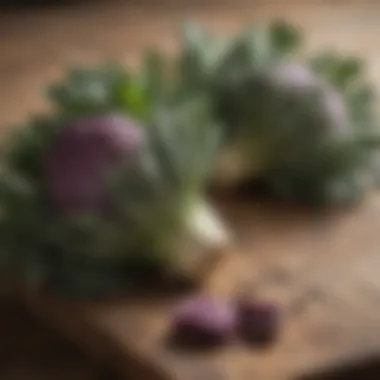
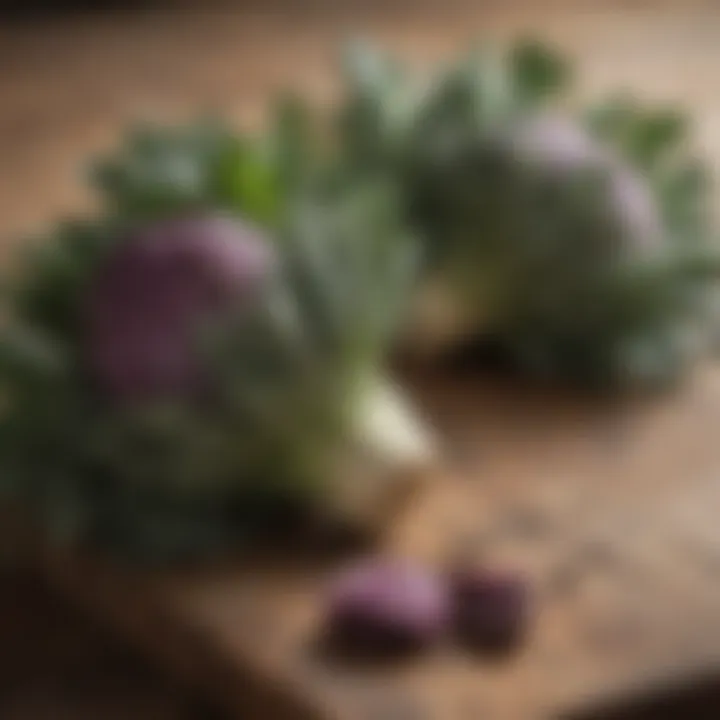
Cardoon is a treasure trove of vitamins and minerals that are pivotal for maintaining good health. Among its highlights, vitamin C and vitamin K take center stage. Vitamin C is a powerful antioxidant that helps bolster the immune system and supports skin health, while vitamin K is crucial for proper blood clotting and bone health. Additionally, cardoon contains folate, which is vital for cell function and tissue growth.
This vegetable also provides important minerals like potassium and magnesium. Potassium aids in maintaining healthy blood pressure levels, while magnesium plays a role in numerous biochemical reactions in the body, including muscle and nerve function. The presence of these nutrients makes cardoon not only a tasty choice but also a smart one for those looking to obtain more from their meals.
Health Benefits
Digestive Health
One standout aspect of cardoon is its role in promoting digestive health. This vegetable is rich in dietary fiber, which is a key player in maintaining regular bowel movements. Fiber helps bulk up stool and can prevent constipation, making it a great option for those looking to improve their gut health. Moreover, fiber acts as a prebiotic, nourishing beneficial gut bacteria that contribute to better digestion and absorption of nutrients.
The unique feature of cardoon's fiber content, particularly in inulin—a type of soluble fiber—has garnered positive attention. Inulin not only supports digestive health but may also help in weight management by promoting a feeling of fullness. Thus, including cardoon in your diet could play an important role in managing weight while improving overall digestive function.
Antioxidant Properties
Cardoon’s antioxidant properties also deserve a spotlight. The presence of various phytochemicals, such as flavonoids, contributes to its ability to combat oxidative stress in the body. Antioxidants protect cells from damage caused by free radicals, which are linked to chronic diseases and aging.
In including cardoon as part of a balanced diet, individuals may therefore experience some protective effects against various health conditions. For instance, its antioxidant capacity might reduce the risk of heart disease by reducing inflammation. By far, the key characteristic of cardoon’s antioxidant profile is its versatility in being incorporated into different dishes while still providing health benefits. This unique feature makes it an attractive choice for those committed to holistic health.
"Incorporating nutrient-rich foods like cardoon into your meals is not only beneficial but also a delightful way to explore new flavors."
Ultimately, the nutritional implications of adding cardoon to one's diet are profound. With an array of vitamins, minerals, and beneficial properties, this often-overlooked vegetable stands up to scrutiny as a worthy contender on the dinner plate. Food lovers and health-conscious individuals alike should pay attention to this unique offering from nature.
Selecting and Storing Cardoon
Selecting and storing cardoon is crucial for maximizing its flavor and culinary potential. Like finding a needle in a haystack, identifying fresh cardoon amongst other vegetables can enhance your cooking experience. Fresh cardoon offers robust taste and texture that dried or improperly stored varieties lack. This section will shed light on how to choose the best cardoon and how to store it properly, ensuring that you use it when it’s at its peak.
Choosing Fresh Cardoon
When it comes to picking fresh cardoon, there are few key indicators to consider. First, look for vibrant color and a firm texture. The stalks should be a bright green and crisp to the touch. Any discoloration or limpness is a red flag for freshness. Pay attention to the leaves too; they should be feathery and not wilted. Often people miss this detail, but fresh leaves contribute to the overall flavor profile.
- Check for Size: Ideally, you want medium-sized stalks. Very large specimens might be more fibrous and tough, while smaller ones might lack flavor.
- Smell: The scent can also inform you. A fresh, earthy aroma means it’s ready to go. If it has a musty odor, steer clear.
A tip for the keen-eyed: if possible, purchase cardoon from local farmers' markets. This ensures you get the freshest produce available, often harvested the same day.
Storage Techniques
Properly storing cardoon is just as important as selecting it right. Here are the best ways to keep your cardoon fresh, maintaining those prized flavors and textures:
- Short-term Storage: If you plan to use cardoon in a couple of days, simply wrap it in a damp paper towel and place it inside a perforated plastic bag in the crisper drawer of your fridge. This method retains moisture while allowing airflow.
- For Longer Storage: Consider blanching the cardoon first. Blanching involves briefly boiling the stalks before plunging them into ice water. This process helps to preserve the color and flavor. After blanching, pack the stalks in airtight containers or freezer bags and store them in the freezer. This is especially useful when you buy cardoon in bulk or want to keep it for off-season use.
Tip: Always label your containers with the date. It helps keep track of freshness over time, ensuring you make the most of that cardoon.
Understanding how to select and store cardoon effectively sets the stage for culinary success. Taking the time to properly choose and maintain this underappreciated vegetable will pay dividends in flavor and enjoyment in the kitchen.
Incorporating Cardoon into Your Diet
When it comes to your everyday meals, adding diversity is key, not just for your palate, but also for your health. That’s where cardoon enters the picture. Its unique flavor and texture can transform a dish from ordinary to exceptional. Understanding how to incorporate cardoon into your diet is vital, as it paves way for healthier eating habits while making the culinary experience enjoyable and exciting.
Recipe Ideas
Cardoon Gratin
Cardoon gratin is a comforting dish that embraces the creamy richness of cheese and the tender crispiness of the cardoon stalks. This dish’s standout feature is its layers of baked goodness, with the cardoon softened and infused with flavors of garlic and herbs. The gratin serves as a fantastic side dish or even a hearty main course for a light meal. Its creamy texture and aromatic profile make it a popular choice.
One aspect that makes cardoon gratin beneficial is its versatility. You can easily experiment with different types of cheese, like parmesan or goat cheese, to suit your taste. Alternatively, considering its somewhat delicate flavor, you might opt for milder options. But there’s always a challenge: some may find that cardoon, when cooked improperly, can become too stringy or fibrous. Therefore, proper preparation and cooking techniques are paramount to achieve the ideal consistency.
Stir-Fried Cardoon with Garlic
Stir-fried cardoon with garlic is a dish that marries simplicity with bold flavors. This preparation highlights the slightly nutty taste of cardoon, elevated by the inclusion of garlic, which is renowned for its myriad health benefits. The crunchy bite of stir-fried cardoon adds a nice dimension to any meal.
What sets this dish apart is how quick and easy it is to prepare. A few minutes on high heat and you have a vibrant dish that stands out on the dinner table. You may also find yourself adjusting the garlic levels based on your preference, making it a customizable option tailored to you.
While it’s mostly advantageous, a downside might be that the cardoon can lose its characteristic crunch if overcooked. So, keeping an eye on it is essential. It’s the simplicity of the dish paired with the nutritional benefits that makes incorporating it into your diet a delightful choice.
Combining Cardoon with Other Ingredients
When playing with cardoon in your kitchen, think about how it synergizes with other ingredients. This veggie partners well with potatoes, where both ingredients meld to create wholesome dishes or even gratins. Add cardoon to soups or stews for a boost of nutrition and a colorful twist. Here are some common pairings:
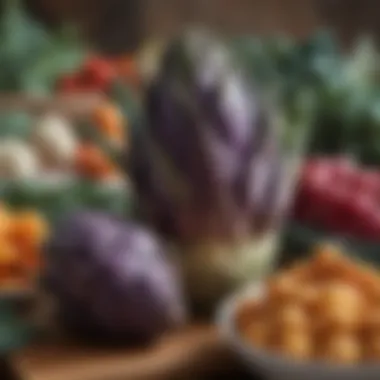
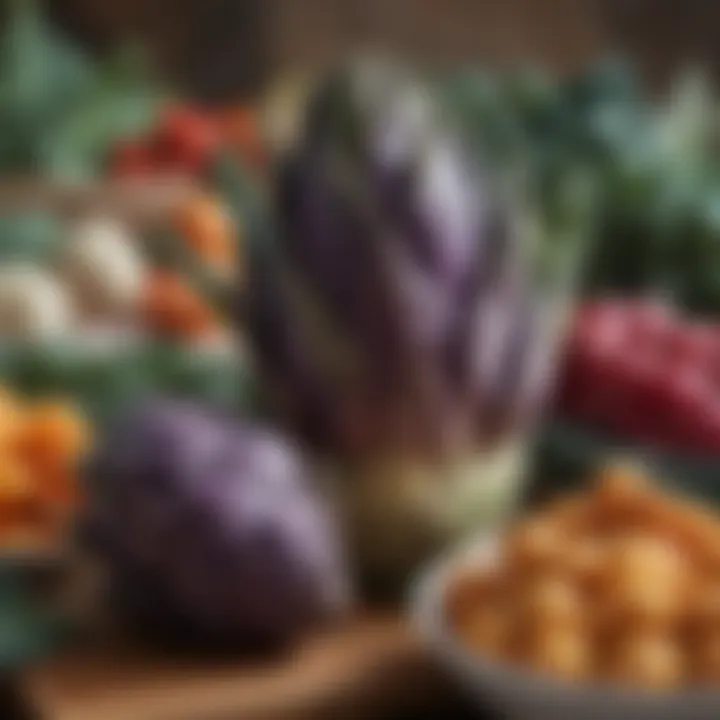
- Cheeses: Parmesan, ricotta, or even feta
- Herbs: Thyme, rosemary, or parsley for a fresh touch
- Nuts: Pine nuts or walnuts for an added crunch
- Proteins: Chicken or fish, as they provide a hearty balance to the dish
From side dishes to mains, its adaptability makes cardoon a strain always worth experimenting with. The right combinations not only enhances the flavor but brings out the unique qualities of cardoon in each dish.
Cultural Significance
The cultural significance of cardoon extends far beyond its culinary applications. This unique vegetable has woven itself into the fabric of various societies, contributing to their customs, rituals, and festivities. Understanding cardoon's role in different cultures can provide a richer appreciation for this underrated ingredient. It not only offers health benefits and nutrition, but it also serves as a symbol of heritage and connection to the land.
Festivals Celebrating Cardoon
In regions where cardoon is a staple, festivals often emerge that celebrate its presence and culinary versatility. One remarkable example is the Festa del Cardo held in the province of Grosseto in Tuscany, Italy. This festival not only showcases cardoon-based dishes but also features cooking competitions, workshops, and food stalls. It brings together local farmers, chefs, and visitors, creating a lively atmosphere filled with music and laughter. Participants come to taste various preparations of cardoon and learn about its health benefits from knowledgeable vendors.
Another celebration, the Fiesta del Cardo in Castilla-La Mancha, Spain, highlights the community's agricultural tradition. The event emphasizes the importance of cardoon in local cuisine while promoting sustainable farming practices. Traditional dances, folk music, and of course, a myriad of cardoon dishes are central to this vibrant festival. These gatherings serve more than just entertainment; they keep the local traditions alive, fostering community spirit and pride.
Historical Uses in Different Cultures
Historically, cardoon played a vital role in various cultures across Europe and the Middle East. In ancient times, the Greeks and Romans cultivated cardoon not only for its culinary uses but also for its medicinal properties. The Romans referred to it as carduus, and it was believed to aid in digestive health and act as a diuretic. Some classical texts even mentioned cardoon in relation to healing and wellness.
In the Middle Ages, cardoon emerged as a popular crop in both Spain and Italy. French chefs, too, recognized its potential and incorporated it into the courts of the French nobility. Recipes from that era highlight the use of cardoon in sauces and soups, showcasing its significance in the evolution of European cuisine.
As one travels through various cultures, cardoon can often be discovered interlaced with local folklore and traditions. For example, in parts of Tunisia, it is common for families to plant cardoon in their gardens, believing it brings good luck and prosperity. This practice reveals not just a culinary use, but a broader cultural appreciation for the vegetable's richness.
In summary, the cultural significance of cardoon is unmistakable. From festive celebrations to historical legacies, it has left its mark in various ways. By exploring these aspects, one can glean a deeper understanding of cardoon's importance as a cherished food source and cultural icon. Embracing such knowledge can enhance one's culinary journey and appreciation for this remarkable vegetable.
Challenges and Considerations
Understanding the challenges and considerations associated with cardoon is crucial for anyone who wishes to incorporate this unique vegetable into their lives. While cardoon boasts a variety of culinary uses and health benefits, there are important factors to keep in mind, especially for those who might be new to this ingredient.
Potential Allergens and Intolerances
Though many enjoy the taste and texture of cardoon, it’s wise to keep an eye on reactions it may cause. Like other members of the Asteraceae family, which includes artichokes and daisies, cardoon can provoke allergic reactions in susceptible individuals.
For those with allergies, common symptoms can range from mild irritations like skin rashes to more serious issues such as gastrointestinal distress. If you know you have sensitivities to related plants, it may be a good idea to introduce cardoon cautiously.
"When in doubt, consult your healthcare provider before trying something new."
If you’re cooking for others, especially in a communal setting or family gathering, it’s essential to inquire about food sensitivities. To ensure a safe dining experience, consider labeling dishes that contain cardoon or other potential allergens.
Environmental Impact of Cardoon Farming
While cardoon is a versatile vegetable, its farming practices also carry responsibility. Cardoon is generally considered a hardy plant which adapts well to various growing conditions, potentially making it advantageous from a sustainability standpoint. However, like any crop, there are environmental impacts worth considering.
- Water Usage: Depending on the region, cardoon cultivation can require a significant amount of water, especially in drier areas. Efforts to optimize water use are essential to prevent depletion of local resources.
- Soil Health: Continuous planting of cardoon without proper crop rotation can deplete soil nutrients. Farmers need to implement sustainable practices, such as rotating cardoon with other crops to maintain soil fertility and structure.
- Pesticide Use: The reliance on chemical pesticides can lead to broader ecosystem issues. As such, choosing organically grown cardoon, if available, can provide an eco-friendlier alternative while supporting sustainable agriculture.
In sum, while the journey into the world of cardoon is certainly appealing, a few mindful considerations can pave the way for a more informed and responsible culinary adventure. Recognizing both potential allergies and the environmental footprint of this vegetable can enrich your appreciation and use of it in a conscientious manner.
Future of Cardoon in Culinary Arts
As culinary landscapes evolve, so does the interest in often overlooked vegetables, including the cardoon. This remarkable plant, often mistaken for an artichoke, has its own unique characteristics and flavors worth showcasing. As the culinary world leans more toward sustainability and farm-to-table practices, cardoon finds itself in a perfect position to become more mainstream.
Cardoon brings a delightful crunch and subtle earthiness that can be a fresh departure from staples like celery or asparagus. Its fibrous texture holds up beautifully in various preparations, encouraging chefs everywhere to experiment. With the rise in popularity of plant-based diets, cardoon is poised to shine on menus. Not just as a side dish but as a feature, encouraging rich exploration of flavors.
The cardoon's current status might be likened to a hidden gem lying beneath the surface, waiting to be polished. This vegetable has the potential to be a main attraction in countless dishes as chefs seek diversity in their ingredients.
Emerging Trends
Across kitchens worldwide, the trend is veering toward less wasteful cooking practices, and cardoon fits snugly within this movement. Given its fibrous nature, even the less desirable parts of cardoon can find new life in stocks and broths. This functionality highlights the importance of reducing waste within the culinary ecosystem.
Interestingly, the vegan and vegetarian movements have resulted in innovative culinary applications of cardoon. More and more vegan chefs are incorporating cardoon into their dishes to add depth and flavor while keeping it entirely plant-based. Cardoon is showing up in everything from salads to entrees, replacing or enhancing traditional ingredients. Moreover, it’s a perfect fit for the Mediterranean-style cooking that continues to gain traction.
Some potential applications include:
- Cardoon Tacos – filling soft tortillas with roasted cardoon, fresh herbs, and avocado.
- Cardoon Hummus – pureeing cooked cardoon with chickpeas for a twist on the classic.
- Cardoon Kimchi – fermenting cardoon with traditional kimchi spices for a crunchy side.
Cardoon in Modern Gastronomy
Within modern gastronomy, where flavors and visuals are paramount, cardoon can offer creativity that is both delicious and appealing. It lends itself well to artistic presentations resembling chef-driven styles that emphasize aesthetics.
Chefs have begun to notice cardoon's potential as a culinary canvas. Its unique shape and color can captivate diners’ attention when incorporated into a dish. Imagine cardoon being pickled and served alongside vibrant, colorful vegetables for an eye-catching charcuterie board.
In high-end dining, cardoon can be paired with gourmet elements such as drizzles of truffle oil or shavings of smoked cheese. This versatility can transform simple dishes into luxurious dining experiences.
Overall, with growing environmental awareness and evolving tastes, cardoon is set to carve out a more prominent place in culinary arts, moving from a niche ingredient to a versatile mainstay on plates around the world.







